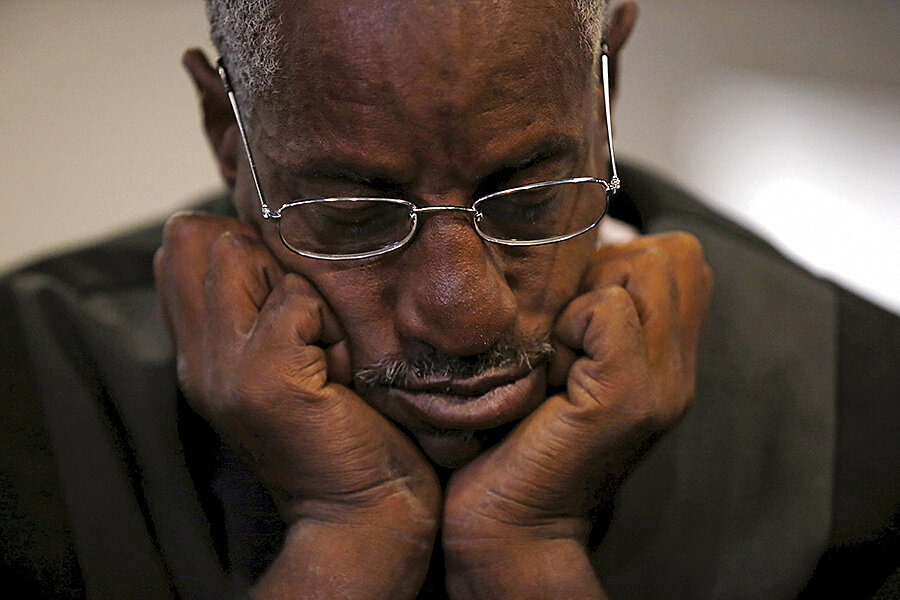An end to homelessness: Cities take on 'impossible' challenge
| Boston
For the first time in decades, communities across the United States are viewing one of the nation’s most intractable problems with fresh and hopeful eyes. They are talking about ending homelessness.
The thrust in the past was often to reduce the problem or at least try to manage it. Cities whipsawed between being tough, instituting sweeps to remove homeless people from highly visible areas, and being compassionate, trying to provide temporary housing and some social services in the hope of keeping them off the streets.
Now some of them are focusing on specific groups of homeless people as a way to begin to solve the problem permanently. Many cities, for instance, have targeted homeless veterans in the wake of a challenge laid down by the Obama administration in 2010. In the past five years, the number of veterans living on the streets has declined by 47 percent. Several cities – including New Orleans, Salt Lake City, Phoenix, and Houston – have eradicated the problem altogether.
Other cities are concentrating on helping homeless children and families. Many are setting more broad-based goals of eliminating homelessness for all people. Minneapolis is in the twilight of a 10-year plan, Heading Home Hennepin, to end homelessness in the area by 2016, while Milwaukee unveiled a plan this summer to eradicate chronic homelessness. Many of these initiatives have been accompanied by better coordination among public and private groups and, significantly, more money.
“At the local level, we are seeing greater political will than we ever have,” says Matthew Doherty, executive director of the US Interagency Council on Homelessness, a federal coordinating body.
None of this is to say that homelessness doesn’t remain a significant problem. In recent months, authorities have declared homeless “states of emergency” in Hawaii, Seattle, Los Angeles, and Portland, Ore. Other locales have taken controversial steps to deal with the crisis on their streets: designating parking lots where people can sleep in their cars and building temporary housing out of repurposed shipping containers. The problem in many cities is sharply rising housing costs that people can no longer afford.
“We’ve gotten to the stage in the economic recovery where there’s a lot of pressure in housing markets,” says Steve Berg, vice president for programs and policy of the National Alliance to End Homelessness.
Yet even in these desperate measures, some see a shift in thinking. Mr. Doherty, for one, says the emergency decrees represent an “increased awareness” of the problem by local politicians. New York Mayor Bill de Blasio recently announced a $2.6 billion housing investment initiative to help the city’s homeless, while Los Angeles wants to devote $100 million to the problem.
Statistically, homelessness isn’t universally bad across the country. Between 2007 and 2015, the number of people sleeping on the street or in emergency shelters on a given night dropped by 12 percent, according to an annual survey by the US Department of Housing and Urban Development. Last year, homelessness declined by at least 5 percent in 23 states.
One reason for optimism among some advocates is that government agencies, service providers, and community groups are getting smarter in trying to solve the problem. In reframing the goal from alleviating to ending homelessness, they are finding more effective ways to prevent people from moving back to the streets and reaching out to those who might not seek help to begin with.
For decades, the public image of homelessness typically featured single, middle-aged men struggling with mental illness and substance abuse issues, and the majority of shelters and services were designed with them in mind, says Mr. Berg. It has become more widely recognized, however, that people experiencing homelessness come from a variety of backgrounds and circumstances. While they all share an immediate need for housing, their other needs vary extensively.
Advocates say another key to the shift toward trying to end rather than just alleviate homelessness has been better coordination among groups serving the population and more backing from political leaders. “We have been able to see the greatest progress for ending homelessness among veterans because we have had bipartisan financial support for housing veterans,” Doherty says.








